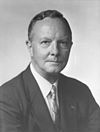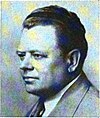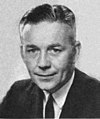Ohio's 19th congressional district was created following the 1830 census and was eliminated after the 2000 census. Between 1863 and 1880, it was represented by future US President James A. Garfield, who became the only sitting House member ever to be elected to the Presidency.
The 20th congressional district of Ohio was created after the 1840 census. It was eliminated in the redistricting following the 1990 census, and redistricted and renumbered as the 10th district.
The 21st congressional district of Ohio was a congressional district in the state of Ohio. It was eliminated in the redistricting following the 1990 census.
The 24th congressional district of Ohio was created for the 1966 election, after the banning of at-large seats by the Voting Rights Act of 1965. It replaced Ohio's at-large congressional district. It was eliminated in the redistricting following the 1970 census. At the time of its creation, it consisted of the southwestern counties of Preble, Butler, Warren and parts of southern and eastern Montgomery.

North Dakota's at-large congressional district is the sole congressional district for the state of North Dakota. Based on size, it is the eighth largest congressional district in the nation.
Ohio's 3rd congressional district is located entirely in Franklin County and includes most of the city of Columbus. The current district lines were drawn in 2022, following the redistricting based on the 2020 census. It is currently represented by Democrat Joyce Beatty.
Ohio's 7th congressional district is represented by Max Miller. It is currently located in the northeastern section of the state, including southern and western Cuyahoga County, all of Medina and Wayne Counties, and a sliver of northern Holmes County.
Ohio's 12th congressional district is a United States congressional district in central Ohio, covering Athens County, Coshocton County, Fairfield County, Guernsey County, Knox County, Licking County, Morgan County, Muskingum County and Perry County along with parts of Delaware, Holmes and Tuscarawas counties. The district includes communities east of Columbus including Zanesville, Cambridge, and Mount Vernon. It is currently represented by Troy Balderson, a member of the Republican Party. Balderson took office following a special election held on August 7, 2018, to replace Rep. Pat Tiberi, who had resigned on January 15, 2018. Balderson was then re-elected in the 2018 general election two months later.

The 16th congressional district of Ohio is an obsolete United States congressional district last represented by Representative Anthony Gonzalez (R). It was last located in the northeast of the state, covering Wayne County and with arms extending north into the suburbs of Cleveland, and east into Greater Akron and Stark County. The district was eliminated upon the swearing in of the 118th United States Congress on January 3, 2023, as the reapportionment after the 2020 census reduced the number of congressional districts in Ohio to fifteen.

The 17th congressional district of Ohio is an obsolete congressional district last represented by Representative Tim Ryan.

The 18th congressional district of Ohio is an obsolete congressional district last represented by Republican Bob Gibbs. The district voted for the majority party in the House of Representatives in every election since 1954.

Pennsylvania's first congressional district includes all of Bucks County and a sliver of Montgomery County in southeastern Pennsylvania. It has been represented by Brian Fitzpatrick since 2019.

Pennsylvania's second congressional district includes all of Northeast Philadelphia and parts of North Philadelphia east of Broad Street, as well as portions of Philadelphia's River Wards. It has been represented by Democrat Brendan Boyle since 2019.
New York's 32nd congressional district was a congressional district for the United States House of Representatives in New York. It was eliminated as a result of the 1990 census. It was last represented by John J. LaFalce who was redistricted into the 29th district.
New York's 33rd congressional district was a congressional district for the United States House of Representatives in New York. It was eliminated as a result of the 1990 census. It was last represented by Henry J. Nowak. Much of this area became part of 30th district during the 1990s, and is now largely in the 27th district.
New York's 35th congressional district was a congressional district for the United States House of Representatives in New York. It was created in 1903 as a result of the 1900 census. It was eliminated as a result of the redistricting cycle after the 1980 census. It was last represented by Barber B. Conable, Jr. who was redistricted into the 30th district.
New York's 37th congressional district was a congressional district for the United States House of Representatives in New York. It was created in 1903 as a result of the 1900 census. It was eliminated as a result of the redistricting cycle after the 1980 census. It was last represented by Henry J. Nowak who was redistricted into the 33rd district.
New York's 38th congressional district was a congressional district for the United States House of Representatives in New York. It was created in 1913 as a result of the 1910 U.S. census and eliminated in 1983 as a result of the redistricting cycle after the 1980 census. It was last represented by Republican Jack Kemp who was redistricted into the 31st congressional district.
New York's 39th congressional district was a congressional district for the United States House of Representatives in New York. It was created in 1913 as a result of the 1910 U.S. census. It was eliminated in 1983 as a result of the redistricting cycle after the 1980 census. It was last represented by Stanley N. Lundine who was redistricted into the 34th congressional district.
The 40th congressional district of New York was a congressional district for the United States House of Representatives in New York. It was created in 1913 as a result of the 1910 census. It was eliminated in 1973 as a result of the 1970 redistricting cycle after the 1970 United States census. It was last represented by Henry P. Smith III who was redistricted into the 36th district.



















